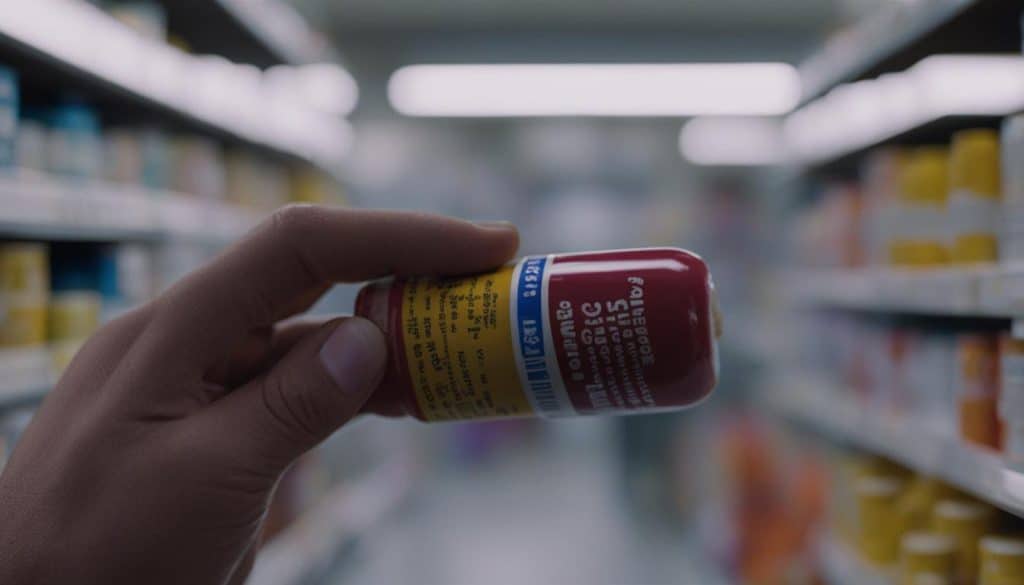If you are a Medicare beneficiary, you are likely familiar with the term “Medicare Donut Hole.” The Medicare Donut Hole is a coverage gap that occurs in Medicare Part D prescription drug plans, where beneficiaries must pay the full cost of their medications. This coverage gap has been a concern for many beneficiaries, causing them to question whether their prescription drug coverage is sufficient.
In 2024, changes were made to address the Medicare Donut Hole, but has it truly closed, or has it only narrowed? In this article, we will explore the current state of the Medicare Donut Hole, its impact on beneficiaries, and the changes that have been made to address this coverage gap.
Key Takeaways:
- The Medicare Donut Hole is a coverage gap that affects Medicare Part D prescription drug plans.
- In 2024, changes were made to address the Medicare Donut Hole, but it may have only narrowed rather than closed entirely.
- The coverage gap affects beneficiaries’ prescription drug coverage and can result in increased out-of-pocket costs.
- There are various strategies and resources available to help beneficiaries manage costs during the coverage gap.
- As an independent Medicare agent, Integrity Now Insurance Brokers can provide assistance and guidance to beneficiaries.
Understanding the Medicare Donut Hole
If you’re a Medicare beneficiary, you’ve probably heard of the Medicare Donut Hole. But what exactly is it, and how does it affect you?
The Medicare Donut Hole is a gap in prescription drug coverage that occurs after you and your drug plan have spent a certain amount of money for covered drugs. In 2022, the Donut Hole starts when you have paid (including deductibles, copayments, and coinsurance) $4,430 in covered drugs.

During the Donut Hole, you will be responsible for a larger share of your drug costs until catastrophic coverage kicks in. This gap in coverage can be costly, which is why it’s important to understand how it works and what your options are for managing your drug costs.
Medicare Donut Hole Calculator
One tool that can help you estimate your out-of-pocket costs during the Donut Hole is a Medicare Donut Hole Calculator. These calculators allow you to enter information about your prescription drugs, drug plan, and expected costs, and will provide an estimate of your expenses during each phase of coverage, including the Donut Hole.
| Medicare Donut Hole Calculator | Cost | Features |
|---|---|---|
| Medicare.gov | Free | Estimates drug costs during the Donut Hole and provides information on financial assistance programs. |
| Q1 Medicare | Free | Provides personalized drug plan comparisons and a Donut Hole calculator. |
| Rxaminer | $14.95 | Offers more detailed analysis of drug costs during the Donut Hole and personalized recommendations for managing costs. |
Using a Medicare Donut Hole Calculator can help you plan for your prescription drug costs and ensure that you are making the most of the coverage available to you.
The Impact of the Medicare Donut Hole on Prescription Drug Coverage
If you have a Medicare drug plan, you may have heard the term Medicare Part D Coverage Gap, also known as the Medicare Prescription Drug Coverage Gap or the Medicare Drug Plan Coverage Gap. This refers to the period of time when your prescription drug costs exceed a certain limit, and you are responsible for paying a greater portion of the cost. The Medicare Part D Coverage Gap is a result of how the prescription drug coverage is structured, and it can have a significant impact on your out-of-pocket costs.
The Coverage Gap typically begins after you and your drug plan have spent a certain amount of money for covered drugs. In 2022, this amount is $4,430. Once you reach this limit, you enter the Coverage Gap, and you are responsible for paying a higher percentage of the cost of your drugs until you reach the out-of-pocket spending limit of $7,050.
During the Coverage Gap, you may be required to pay up to 25% of the cost of your brand-name prescription drugs and up to 37% of the cost of generic drugs. This can be a significant financial burden, especially for those with chronic conditions. And, not all drugs are included in the Coverage Gap. For example, Medicare doesn’t cover drugs used for weight loss or cosmetic purposes.
The impact of the Medicare Donut Hole on beneficiaries’ prescription drug coverage can be significant. Prescription drug costs can be a financial burden for many seniors and disabled individuals, and Medicare Part D provides important coverage to manage those costs. However, once beneficiaries reach the Coverage Gap, they are left to pay a higher portion of the cost. Knowing how the Coverage Gap works and what drugs are included in it can help you plan for and manage your out-of-pocket costs.

The Medicare Prescription Drug Coverage Gap by the Numbers:
| Original Medicare | With Part D Coverage | In Coverage Gap | Out of Coverage Gap | |
|---|---|---|---|---|
| Total Drug Costs | $10,000 | $10,000 | $1,000 | $9,000 |
| You Pay | $5,100 | $3,500 | $450 | $225 |
| Medicare Pays | $4,800 | $6,000 | $550 | $8,775 |
“Understanding the Medicare Prescription Drug Coverage Gap can be confusing, but it’s important to know how it works and how it impacts your overall healthcare costs.” – Integrity Now Insurance Brokers
Closing the Medicare Donut Hole: Changes in 2024
Since the introduction of Medicare Part D in 2006, the Medicare Donut Hole has been a persistent issue for beneficiaries. However, in 2024, changes were made to address the coverage gap and provide relief for those impacted by its effects. These changes aim to either close or narrow the coverage gap, reducing out-of-pocket costs for beneficiaries.
One of the main changes in 2024 is the increase in manufacturer discounts for brand-name drugs. The discount has increased from 70% to 75%, reducing the amount beneficiaries have to pay for these drugs while in the coverage gap. Additionally, the amount of money beneficiaries have to spend out-of-pocket before reaching catastrophic coverage has been reduced, offering further financial relief.
It’s important to note that not all drugs are included in the coverage gap. Generic drugs, for instance, are typically not subject to increased costs during the gap. Additionally, different Medicare drug plans may offer different levels of coverage, so it’s important to review plan details carefully to understand specifics.
If you still find yourself struggling with the effects of the Donut Hole, there may be options available to you. Integrity Now Insurance Brokers is an independent Medicare agent that can help navigate the coverage gap and identify potential resources or assistance programs. Don’t hesitate to reach out for support during this challenging period.

Cost Considerations in the Medicare Donut Hole
Managing the costs of prescription drugs during the Medicare Donut Hole can be challenging. However, there are strategies and resources available to help mitigate these expenses.
Estimating Your Donut Hole Costs
One helpful tool to estimate your out-of-pocket costs is a Medicare Donut Hole Calculator. This tool can help you determine how much you will pay for prescription drugs based on their retail price. You can also review your Explanation of Benefits to help track your medication costs and see when you may be entering the Donut Hole.
Strategies to Manage Donut Hole Costs
There are several strategies you can use to help manage the costs of prescription drugs during the Donut Hole:
- Opt for generic drugs when possible
- Discuss drug plan options with your healthcare provider
- Look into patient assistance programs offered by drug manufacturers
- Consider a Medicare Supplement Insurance Plan to help cover costs
Resources for Assistance with Prescription Drug Costs
There are several resources available to help with the costs of prescription drugs:
- The Extra Help program offered by Social Security can provide subsidies for prescription drug coverage
- Patient advocacy organizations like the National Council on Aging and the Medicare Rights Center offer assistance with drug coverage
- Integrity Now Insurance Brokers, an independent Medicare agent, can help you navigate the Medicare system and find coverage options that fit your needs and budget

With some planning and research, you can take steps to manage the costs of prescription drugs during the Medicare Donut Hole. Don’t hesitate to reach out to resources like Integrity Now Insurance Brokers for help in finding the right coverage for you.
Understanding Medicare Part D and the Medicare Donut Hole
Medicare Part D is a voluntary prescription drug program that helps Medicare beneficiaries pay for their prescription drugs. It is offered through private insurance companies, and beneficiaries choose a drug plan based on their individual needs. Part D coverage includes a standard deductible, a initial coverage period, a coverage gap (also known as the Medicare Donut Hole), and catastrophic coverage.
The Medicare Donut Hole refers to the coverage gap in Medicare Part D drug plans. It is the point in which beneficiaries must pay a larger portion of their prescription drug costs until they reach a certain threshold. Prior to 2010, beneficiaries were responsible for 100% of the costs during this phase. However, the Affordable Care Act (ACA) implemented changes to the coverage gap, and by 2020 the Donut Hole was reduced to 25% of the total cost of covered brand-name drugs, and further reductions to this gap are coming in 2024.
It is important to note that only certain drugs are counted toward reaching the threshold for the Donut Hole. Specifically, it includes the amount paid by the beneficiary and the drug plan for covered prescription drugs that are not a generic or preferred brand drug.
Medicare beneficiaries must enroll in a Part D Prescription Drug Plan or in a Medicare Advantage Plan that includes prescription drug coverage to receive prescription drug benefits. Most beneficiaries enroll in a stand-alone Part D Prescription Drug Plan, while some chose to enroll in a Medicare Advantage Plan that includes drug coverage.
| Phase of Coverage | Coverage by Beneficiary | Coverage by Part D Plan |
|---|---|---|
| Initial Coverage Period | – | 75% of drug costs covered |
| Coverage Gap (Donut Hole) | 25% of drug costs and some Manufacturer discounts* | Vary by plan |
| Catastrophic Coverage | 5% of drug costs, or $3.95/$8.15 for generic and brand-name drugs respectively | 95% of cost covered, drug manufacturer pays 70%, Part D plan pays 15% |
“Enrolling in Part D can be complex and confusing. It is in your best interest to consult with experienced and licensed Medicare agents like Integrity Now Insurance Brokers. We can help identify your needs and match you with the plan that best meets your needs.”

Exploring Medicare Donut Hole Coverage Options
When faced with the Medicare Donut Hole, it’s important to understand what coverage options are available to you as a beneficiary. Here are some strategies to manage costs during the coverage gap:
- Supplemental Insurance Plans: Consider purchasing a Medicare Supplement plan (also known as Medigap) to lower out-of-pocket costs. These plans can help cover expenses such as co-payments, deductibles, and coinsurance.
- Generic Drug Savings: Switching to generic drugs can also help save money. Generic drugs are just as safe and effective as brand-name drugs, but they cost less. Check with your doctor or pharmacist for generic alternatives.
- State Pharmaceutical Assistance Programs: Some states offer assistance programs for Medicare beneficiaries with limited income and resources. These programs can help cover prescription drug costs during the Donut Hole. Check with your State Health Insurance Assistance Program (SHIP) for more information.
If you’re still unsure about what Medicare Donut Hole coverage options are available to you, Integrity Now Insurance Brokers is here to help. Our independent Medicare agents can provide guidance and support as you navigate the complex world of Medicare. Contact us today to learn more.
The Role of Integrity Now Insurance Brokers in Medicare Donut Hole Coverage Options
At Integrity Now Insurance Brokers, we understand that choosing the right Medicare coverage options can be overwhelming. Our independent Medicare agents are here to help you navigate your options and choose the coverage that’s right for you. Contact us today to schedule a consultation.

Navigating the Medicare Donut Hole as a Medicare Beneficiary
As a Medicare beneficiary, the Medicare Donut Hole can be a challenging scenario to navigate. However, with the right knowledge and guidance, you can manage your healthcare expenses during this coverage gap effectively.
Firstly, it’s essential to review your drug plan coverage to understand which prescription drugs are covered and which are not. By doing so, you can avoid any unexpected costs that may arise due to lack of coverage.
Pro Tip: Consider switching to generic drugs to save on medication costs. They may provide the same benefits as their brand-name counterparts, reducing your out-of-pocket expenses.
Secondly, talk to your healthcare providers about your options during the coverage gap. They can offer insight into alternative treatments or medication plans that may be more affordable or better-suited to your needs.
Lastly, staying informed about changes in the Medicare Donut Hole can help you plan accordingly. By keeping up-to-date with any updates or modifications, you can adjust your healthcare strategy accordingly.
The team at Integrity Now Insurance Brokers is here to help you navigate the Medicare Donut Hole. As an independent Medicare agent, we can provide insight into coverage options and guidance on managing healthcare expenses. Contact us today to learn more.

Resources and Assistance for Medicare Donut Hole Coverage
As you navigate the complexities of Medicare Donut Hole coverage, it’s important to know that you’re not alone. There are a variety of resources and assistance programs available to help you manage your out-of-pocket costs and make informed decisions about your healthcare needs.
One important resource to consider is financial assistance programs offered through Medicare, such as the Medicare Low Income Subsidy (LIS) program. This program provides assistance with prescription drug costs for those who qualify based on income and asset criteria. To see if you qualify for LIS, contact Integrity Now Insurance Brokers, an independent Medicare agent who can help you understand the application process and your eligibility.
Another helpful resource is patient advocacy organizations, such as the Medicare Rights Center or the National Council on Aging. These organizations offer free counseling and support to Medicare beneficiaries, helping you explore your options and make informed decisions about your healthcare coverage.
Finally, government resources such as the Medicare website or the State Health Insurance Assistance Program (SHIP) can provide helpful information about Medicare Donut Hole changes and the coverage options available to you. SHIP offers free, personalized counseling to Medicare beneficiaries and can help you navigate the complexities of Medicare coverage.
Financial Assistance Programs for Medicare Donut Hole Coverage
| Program | Description |
|---|---|
| Medicare Low Income Subsidy (LIS) Program | Provides assistance with prescription drug costs for those who qualify based on income and asset criteria. |
| Extra Help Program | Provides assistance with Medicare prescription drug plan costs for those who qualify based on income and asset criteria. |
| State Pharmaceutical Assistance Programs (SPAPs) | Provides assistance with prescription drug costs for those who do not qualify for other assistance programs. |

Remember, as a Medicare beneficiary, you have a variety of resources and assistance programs available to help you navigate the Medicare Donut Hole. Don’t hesitate to reach out to Integrity Now Insurance Brokers or other reliable sources for guidance and support.
Conclusion
Now that you understand the ins and outs of the Medicare Donut Hole, it’s important to take action and explore your options. By staying informed about changes to the coverage gap and reviewing your drug plan coverage, you can make the most of your Medicare benefits and minimize out-of-pocket costs.
Remember, you don’t have to navigate the Medicare Donut Hole alone. As an independent Medicare agent, Integrity Now Insurance Brokers can provide personalized guidance and assistance to help you find the coverage options that work best for you. Don’t hesitate to reach out and get the help you need.
In summary, while the Medicare Donut Hole may have closed or narrowed in 2024, it’s still important to stay informed and be proactive about managing your prescription drug costs. With the right information and resources, you can make the most of your Medicare coverage and enjoy greater peace of mind when it comes to your healthcare.
FAQ
Has the Medicare Donut Hole truly closed or just narrowed in 2024?
The Medicare Donut Hole has undergone changes in 2024, but it has not completely closed. Instead, the coverage gap has been narrowed, providing beneficiaries with some relief from high out-of-pocket costs for prescription drugs.
What is the Medicare Donut Hole and how does it affect beneficiaries?
The Medicare Donut Hole is a coverage gap in Medicare Part D prescription drug plans. It occurs when a beneficiary’s total drug costs reach a certain threshold. During this gap, beneficiaries are responsible for a higher percentage of their drug costs until they reach catastrophic coverage. This can lead to substantial out-of-pocket expenses for certain medications.
How does the Medicare Donut Hole impact prescription drug coverage?
The Medicare Donut Hole affects beneficiaries’ prescription drug coverage by increasing their out-of-pocket costs. Once they enter the coverage gap, they are responsible for paying a percentage of the drug costs until they reach the catastrophic coverage threshold. Not all medications are covered in the gap, which can lead to significant financial burdens for some beneficiaries.
What changes were made to the Medicare Donut Hole in 2024?
In 2024, changes were implemented to address the Medicare Donut Hole. These changes narrowed the coverage gap, reducing the percentage of drug costs that beneficiaries are responsible for during the gap. The goal was to provide more affordable access to medications for Medicare beneficiaries.
What are the cost considerations in the Medicare Donut Hole?
The Medicare Donut Hole brings about important cost considerations for beneficiaries. During the coverage gap, beneficiaries may face high out-of-pocket expenses for prescription drugs. It is important for beneficiaries to explore cost-saving strategies, such as using generic drugs or seeking financial assistance programs, to manage their expenses in the Donut Hole.
How does Medicare Part D and the Medicare Donut Hole relate to each other?
Medicare Part D is the prescription drug coverage portion of Medicare, and the Medicare Donut Hole is a coverage gap within Part D. Beneficiaries enroll in Part D plans to help cover their prescription drug costs, including the costs incurred during the Donut Hole. Understanding how Part D and the Donut Hole work together is crucial for beneficiaries to make informed decisions about their drug coverage.
What coverage options are available during the Medicare Donut Hole?
There are several coverage options available to beneficiaries during the Medicare Donut Hole. These include supplemental insurance plans, which can help cover some of the costs in the gap, and taking advantage of savings on generic drugs. Beneficiaries are also encouraged to explore patient assistance programs and seek guidance from their healthcare providers to find the most suitable options for their situation.
How can beneficiaries navigate the Medicare Donut Hole?
Navigating the Medicare Donut Hole can be complex, but there are steps beneficiaries can take to manage their coverage gap. It is recommended to review drug plan coverage, discussing options with healthcare providers, and staying informed about changes in the Donut Hole. Seeking guidance from a trusted Medicare agent can also be beneficial in understanding coverage options and making informed decisions.
What resources and assistance are available for Medicare Donut Hole coverage?
There are various resources and assistance programs available to help beneficiaries with Medicare Donut Hole coverage. These include financial assistance programs, such as Extra Help, which provides subsidies for prescription drug costs. Additionally, patient advocacy organizations and government resources can offer guidance and support. It is important for beneficiaries to explore these resources to ease the financial burden of the Donut Hole.
What should I do next to learn more about the Medicare Donut Hole?
To learn more about the Medicare Donut Hole and how it may affect you or a loved one, it is recommended to seek further information or assistance from a trusted Medicare agent like Integrity Now Insurance Brokers. They can provide personalized guidance and help you navigate the complexities of the Medicare system.










